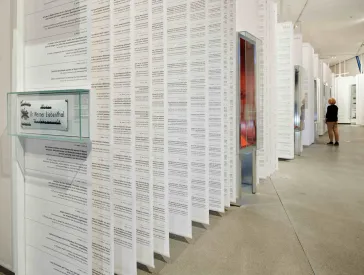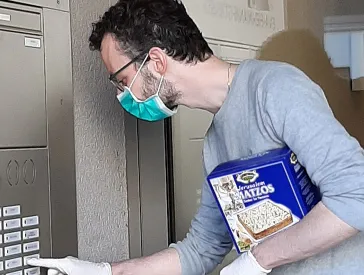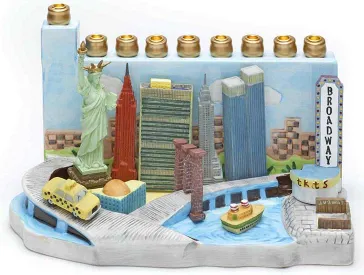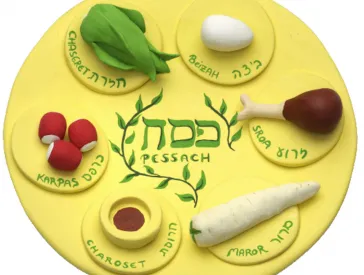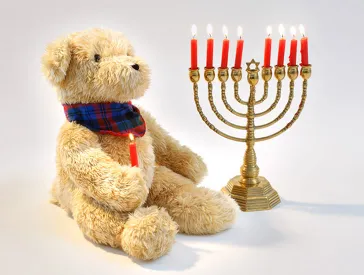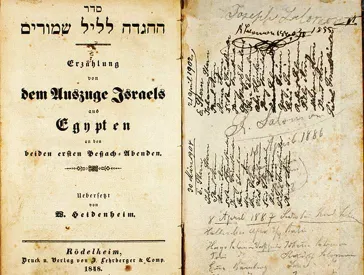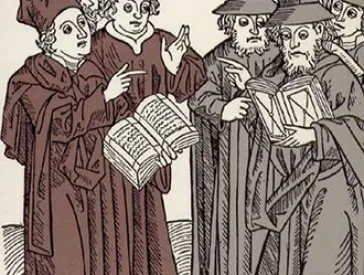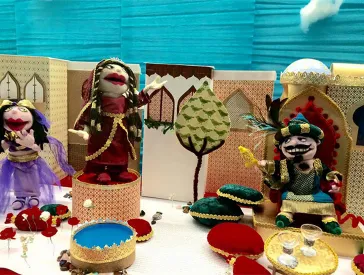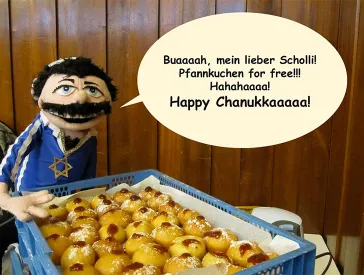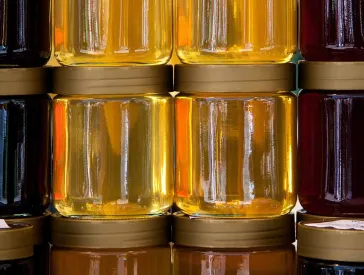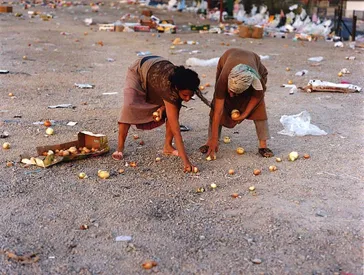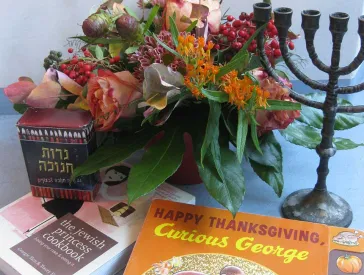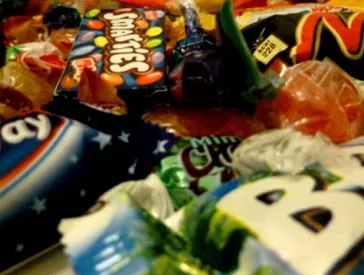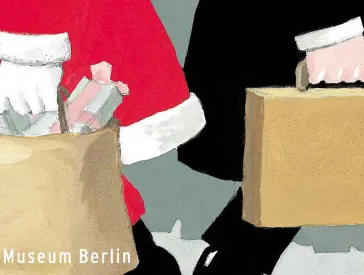Hanukkah Lasts Eight Days...
And for Each Day, We’ve Got a Little Treat for You Here
1. When Does It Start?
According to the Hebrew calendar, the festival begins on the eve of the 25th of Kislev. The months of the Jewish calendar are organized around the phases of the moon, which is why the 25th of Kislev can’t be converted to a specific date in the Gregorian calendar.
Nevertheless, festivals and holidays each take place during a certain season so they remain aligned with the solar year. Every two or three years, the Jewish calendar inserts an extra “leap month” that almost perfectly makes up for the discrepancy between the length of the lunar and solar years.
For this reason, Jewish holidays don’t shift around the entire Gregorian year, as does the Muslim fasting month of Ramadan, for example. This is why the first day of Hanukkah usually falls sometime in December, although occasionally it starts in late November.
People who celebrate Hanukkah get out their Hanukkah menorah, or hanukiah, and prepare it for the eight days of candle lighting. Customarily, it is positioned in a highly visible spot outside the home or in the window in order to make the miracle of Hanukkah public. The first candle is lit on the first night, then two are lit on the next night, etc. – one more candle each night than the night before.
Hanukkah, the festival of lights, celebrates the restoration of the second Jewish Temple in Jerusalem and an associated miracle. We can’t offer you any genuine miracles here, but we’re happy to share a few wondrous discoveries from our museum’s holdings and from the far reaches of the world-wide web. Incidentally, on Hanukkah, the Jewish Museum usually hosts a small ceremony each day with candle-lighting and music. Everyone is welcome to come and participate. Please check our calendar of programs for the current dates in good time.
2. Which Candle Comes First?
Do you know whether to put the candles from left to right or from right to left into the hanukkiah and from which side you should start lighting the candles? Find out now with one of the most beautiful genres – the explanatory film:
Video by the Israeli YouTube channel Yahaduton
3. What’s the Right Hanukkah Menorah for Me?
There are not many requirements for a hanukkah lamp. The basic elements are eight candle (or oil) holders arranged in a straight line. The ninth branch (called the “shamash” or “servant”) is used to light the others. The rest is up to the designer …
Several Hanukkah Menorahs from Our Collection
-
Hanukkah menorah by Johann Gottlieb Halbritter, Feuchtwangen, about 1830; Jewish Museum Berlin, accession 2004/66/0, photo: Roman März. Further information about this object can be found in our online collections (in German)
-
Hanukkah Menorah made by Ludwig Wolpert, patinated cast brass, 34 cm tall and 38 cm wide, Frankfurt am Main, 1924; Jewish Museum Berlin, accession 2021/136/0, purchased with the support of the Friends of the Jewish Museum Berlin, photo: Roman März. Further information about this object can be found on our website
-
Hanukkah menorah by Erna Weill (1904–1996), USA, 1936 according to signature; Jewish Museum Berlin, accession 2014/84/0, photo: Roman März. Further information about this object can be found in our online collections (in German)
-
Hanukkah lamp New York City Skyline Memorial Menorah, designed by Shepsil Scheinberg; Jewish Museum Berlin, accession 2004/192/0, photo: Jens Ziehe. Further information about this object can be found in our online collections (in German)
-
Hanukkah set with lamp for children, China, about 2004; Jewish Museum Berlin, accession 2004/184/0, photo: Jens Ziehe. Further information about this object can be found in our online collections (in German)
-
Electric hanukkah lamp from the office of the New Yorker newspaper Aufbau, USA, about 1970 to 2000; Jewish Museum Berlin, accession 2004/649/0, photo: Jens Ziehe
-
Hanukkah menoah, Emil Freund Metalworks and Silversmithy, Hanau, about 1900 to 1935; Jewish Museum Berlin, accession KGM 81/165/0, purchased with funds provided by Stiftung DKLB, photo: Jens Ziehe. Further information about this object can be found in our online collections (in German)
-
Hanukkah menorah featuring Statues of Liberty by Manfred Anson, USA, 2005; Jewish Museum Berlin, accession 2005/89/0, photo: Jens Ziehe. Further information about this object can be found in our online collections (in German)
4. What’s for Dinner?
Traditionally, latkes (fried potato pancakes) and sufganiot (jelly doughnuts). Because Hanukkah isn’t Hanukkah without oil, but it’s easy enough to prepare these foods without animal products, we’ve got recipes for each in traditional and vegan versions:
Recipes for Latkes and Sufganiot (traditional)
Latkes
Ingredients (4 servings)
- 6 medium-large potatoes
- 1 medium onion
- 2 eggs, beaten
- 60 g of flour
- Salt and freshly ground pepper to taste
- Vegetable oil for frying
- Applesauce
- Sour cream
Instructions
Finely grate the potatoes and onion. Drain the mixture in a sieve and squeeze out as much liquid as possible.
Transfer the mixture to a large bowl and add the eggs, the flour, salt and pepper, and mix until the flour is absorbed.
Heat the oil in the pan. Pour the dough into the hot oil one tablespoon at a time and fry for about two minutes. When the edges of the latkes are brown and crispy, flip. Cook until the second side is deeply browned. Drain on kitchen paper. Place the latkes on a serving plate and keep warm in the oven.
Serve warm with applesauce and the optional sour cream.
Sufganiot
Ingredients
- 40 g of yeast
- 6 tsp of sugar
- 500 g flour
- Juice from an orange
- 1 egg
- 3 tbsp butter
- Vegetable oil for frying
- Icing sugar
Instructions
In a small bowl, combine yeast, warm water, and two teaspoons of sugar. Set aside until foamy, about 15 minutes.
Place flour in a large bowl, add the orange juice, the egg, butter, a tablespoon of oil, four teaspoons of sugar and the yeast mixture. Stir until a dough forms. On a well-floured work surface, knead until dough is smooth. Leave for about an hour until the dough has doubled in size.
After an hour has passed, bring the dough out and give it a quick knead and then place on a floured surface. Use a rolling pin to flatten the dough to approx 1 cm thickness. Use a round cookie cutter to cut pieces that will form your doughnuts. Place the round pieces of dough onto a floured baking tray and cover with cling film or towel and let stand for 30 minutes so that they can raise again.
Pour the frying oil into a medium sized saucepan so that the oil will be approx 5 cm in depth. Heat the oil to a medium heat. Fry the doughnuts until they are a golden colour and then flip to heat the other side. Lift the doughnuts and place into the oil with the side that was on the surface, now facing up. Once both sides are cooked, move the doughnut to a paper towel to absorb the oil before placing onto a cooling rack or straight to the plate. Wait for the doughnuts to cool and then dust them with the icing sugar.
Recipes for Latkes and Sufganiot (vegan)
Latkes
Ingredients (4 servings)
- ¾ cup quick-cooking oats or quinoa flakes
- 6 medium-large potatoes
- 1 medium onion
- ½ cup matzo meal (or ½ cup additional quinoa flakes)
- Salt and freshly ground pepper to taste
- Vegetable oil for frying
- Applesauce
- Vegan sour cream
Instructions
In a heatproof bowl, combine the oats or quinoa flakes with 1½ cups boiling water.
Finely grate the potatoes and onion. Drain the mixture in a sieve and squeeze out as much liquid as possible.
Combine the grated potatoes and onions and the matzo flour in a mixing bowl. Stir in oats and season with salt and pepper.
Heat the oil in a pan. Pour the dough into the hot oil one tablespoon at a time and fry for about two minutes. When the edges of the latkes are brown and crispy, flip. Drain on kitchen paper. Place the latkes on a serving plate and keep warm in the oven.
Serve warm with applesauce and the optional vegan sour cream.
Sufganiot
Ingredients
- 500 g flour
- 200 ml soy milk
- 6 tsp of sugar
- Juice from an orange
- a pinch of salt
- 40 g of yeast
- 300 ml sunflower oil
- 1 tsp vanilla sugar
- Powdered sugar for dusting
Instructions
Blend all the dried ingredients together in a large bowl. Warm the soy milk. Add the soy milk to the dry ingredients along with the remaining ‘wet’ ingredients.
Blend the mixture together until it forms a dough and then knead this for 10 minutes until you get a very soft dough. Bring the dough back to the bowl, cover with a towel and set it in a warm area in the kitchen. Leave for about an hour until the dough has doubled in size.
After an hour has passed, bring the dough out and give it a quick knead and then place on a floured surface. Use a rolling pin to flatten the dough to approx 1 cm thickness. Use a round cookie cutter to cut pieces that will form your doughnuts. Place the round pieces of dough onto a floured baking tray and cover with cling film or towel and let stand for 30 minutes so that they can raise again.
Pour the frying oil into a medium sized saucepan so that the oil will be approx 5 cm in depth. Heat the oil to a medium heat. Fry the doughnuts until they are a golden colour and then flip to heat the other side. Lift the doughnuts and place into the oil with the side that was on the surface, now facing up. Once both sides are cooked, move the doughnut to a paper towel to absorb the oil before placing onto a cooling rack or straight to the plate. Wait for the doughnuts to cool and then dust them with the icing sugar.
And here’s what they look like:
In Yiddish they are called latkes, in Hebrew levivot. You can see them on the left of the image. For Hanukkah, they are served either sweet (with applesauce) or savory (with sour cream), or even both at once; right: sufganiot; Jewish Museum Berlin, photos: Franziska Schurr
5. What Should We Play?
The dreidel (also dreidl, dreidle, dreydel, and draydel; sevivon in Hebrew) is a spinning top used to play the traditional dreidel game during Hanukkah.
The four sides of the top, which is shaped like a die, bear the Hebrew letters nun, gimel, hay, and shin (or peh). These are the first letters of the words in the sentence “Nes gadol hayah sham” (or “Nes gadol hayah poh”), which means “A great miracle happened there” or “A great miracle happened here” – depending on whether the game is played in the Diaspora or in Israel.
Game Instructions
To play the dreidel game, each player first puts an agreed-upon number of playing pieces in the middle of the table.
These pieces can be chocolate Hanukkah coins or any countable object. Usually the youngest player begins. The players take turns spinning the top, and the letter that faces up when it stops determines the player’s next action.
Junge mit Trendelspiel (“Boy with Dreidel”) by Herbert Sonnenfeld, Berlin 1934; Jewish Museum Berlin, accession FOT 88/500/334/091, purchased with funds provided by Stiftung DKLB. More photos by Herbert Sonnenfeld showing Hanukkah motifs can be found in our online collections (in German)
- “Nun” stands for “nothing,” so the most recent player to spin the dreidel doesn’t win or lose anything.
- “Gimel” means “good” or “complete”: the player is in luck and gets to keep everything in the pot.
- “Hay” means “half”: the player gets half of what is in the pot.
- “Shin” or “peh” means “bad”: the player must place one or two coins from their play money in the middle of the table.
When a player has lost all of their money, they are out of the game.
Our Hanukkah Gelt is ready… You can learn more about Hanukkah gelt from Michal Friedlander’s essay “If I were a rich mouse...” on this website.
DIY
The rules of the game are also available for download on our dreidel tinkering sheet. In order to make the dreidel, you will need scissors, some glue and a pencil.
Download (PDF / 181.4 KB / in German / not accessible)6. What’s the Soundtrack?
There are some traditional Hanukkah songs and some very unconventional ones. Decide for yourself which of these fit in which category...
Hanukkah Songs
7. What about Gifts?
Traditionally, gifts were not given on Hanukkah. However, over the years, the Jewish festival has developed a gift-giving tradition, which you can read about in the post The Commercialization of Hannukah. So it should be no surprise our collection includes some objects of fluffy Hanukkah kitsch – made in China.
Something for Everyone?
8. And What Is Chrismukkah?
Hanukkah and Christmas have some things in common: both holidays incorporate lights and candles to make a dark time of year more pleasant. Both holidays are on the 25th of a month and begin on the night before – Christmas on the 25th of December, and Hanukkah on the 25th of Kislev, the ninth month of the Jewish calendar. Both holidays evolved as a mixture of tradition, family celebration, and consumer frenzy. In 2005–06, the Jewish museum even put on an exhibition devoted to all these themes: Chrismukkah: Stories of Christmas and Hanukkah (more about it on our exhibition website).
In Christian-majority societies, the ubiquity of the Christmas season can sometimes be a cause for conflict, which in the United States has been called the “December dilamma.”
Yet the “December dilemma” has also led to new holiday traditions. Jewish families have elevated the importance of Hanukkah as a holiday and give their children gifts for each of the eight days. Secular people and companies send religiously neutral greeting cards labeled “Seasons Greetings” or “Happy Holidays.” And interfaith families, groups of friends, and other groups – such as this museum’s staff – sometimes celebrate a hybrid amalgamation of both festivals as Chrismukkah.
Character Seth Cohen on the television series The O.C.
For more details on the historical origins of the holiday and information on some of the customs, you can read a post by our dear colleague David Studniberg on this website, Hanukkah: “8 Facts” about the Jewish Feast of Dedication.
Citation recommendation:
Jewish Museum Berlin (2017/20), Hanukkah Lasts Eight Days.... And for Each Day, We’ve Got a Little Treat for You Here.
URL: www.jmberlin.de/en/node/7573
Holidays: Old Rituals, New Customs (19)
